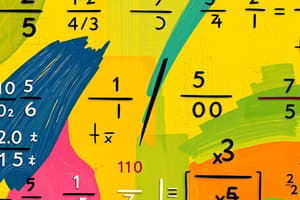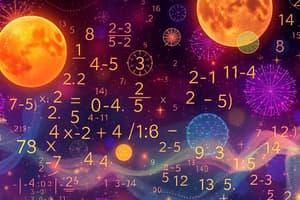Podcast
Questions and Answers
What is the correct order of operations when evaluating the expression $3 + 5 \times 2 - 8$?
What is the correct order of operations when evaluating the expression $3 + 5 \times 2 - 8$?
- Add, multiply, then subtract
- Add, subtract, then multiply
- Subtract, then add and multiply
- Multiply, then add and subtract (correct)
Which of the following is true when converting the fraction $
rac{3}{4}$ to a decimal?
Which of the following is true when converting the fraction $ rac{3}{4}$ to a decimal?
- It cannot be expressed as a decimal
- It equals 0.75 (correct)
- It equals 0.5
- It equals 0.33
Which statement about ratios and proportions is correct?
Which statement about ratios and proportions is correct?
- Proportions are always expressed as fractions.
- Ratios show comparison, while proportions state equality between two ratios. (correct)
- A ratio can only compare two different types of quantities.
- There is no relationship between ratios and proportions.
What is the mean of the following set of numbers: 5, 10, 15, 20?
What is the mean of the following set of numbers: 5, 10, 15, 20?
What describes a function in terms of input and output?
What describes a function in terms of input and output?
Flashcards are hidden until you start studying
Study Notes
Key Concepts in Mathematics Part 1
1. Basic Arithmetic
- Addition, subtraction, multiplication, division
- Order of operations (PEMDAS/BODMAS)
- Properties of numbers (commutative, associative, distributive)
2. Fractions
- Definition: A ratio of two integers
- Operations: Addition, subtraction, multiplication, division
- Simplifying fractions and finding common denominators
3. Decimals
- Definition: A fraction expressed in decimal form
- Conversion between fractions and decimals
- Operations with decimals (alignment of decimal points)
4. Percentages
- Definition: A part per hundred
- Conversion between fractions, decimals, and percentages
- Calculating percentages of quantities
5. Ratios and Proportions
- Ratio: Comparison of two quantities
- Proportion: An equation stating that two ratios are equal
- Solving problems involving ratios and proportions
6. Algebra Basics
- Variables and constants
- Simple equations and expressions
- Solving linear equations (one variable)
7. Geometry Fundamentals
- Basic shapes (triangles, squares, circles)
- Perimeter and area calculations
- Volume of basic 3D shapes (cubes, cylinders)
8. Data and Statistics
- Mean, median, mode: Measures of central tendency
- Range: Difference between the highest and lowest values
- Basic concepts of probability
9. Introduction to Functions
- Definition of a function: Mapping from input to output
- Understanding domain and range
- Evaluating functions for specific inputs
10. Number Systems
- Natural numbers, whole numbers, integers, rational numbers, irrational numbers
- Real numbers and their properties
- Understanding and using exponents and square roots
Tips for Studying Mathematics
- Practice regularly with exercises and problems.
- Break down complex problems into smaller, manageable parts.
- Use visual aids (like graphs and diagrams) to understand concepts better.
- Review mistakes to learn and avoid them in the future.
Basic Arithmetic
- Fundamental operations include addition, subtraction, multiplication, and division.
- Order of operations follows the rules PEMDAS (Parentheses, Exponents, Multiplication and Division, Addition and Subtraction) or BODMAS (Brackets, Orders, Division and Multiplication, Addition and Subtraction).
- Properties of numbers consist of commutative (order does not matter), associative (grouping does not matter), and distributive (multiplying a number by a sum).
Fractions
- A fraction represents the relationship between two integers, written as a/b where 'a' is the numerator and 'b' is the denominator.
- Operations on fractions include addition, subtraction, multiplication, and division.
- Simplifying fractions involves reducing to the lowest terms, while finding common denominators is essential for addition and subtraction.
Decimals
- A decimal is a fractional representation in base 10.
- Conversion between fractions and decimals can involve long division or multiplication to achieve equivalent values.
- Performing operations with decimals requires careful alignment of decimal points for accurate results.
Percentages
- A percentage quantifies a part per hundred, often denoted by the symbol %.
- Conversions between fractions, decimals, and percentages simplify calculations and comparisons.
- Calculating the percentage of a quantity involves multiplying the quantity by the percentage expressed as a decimal.
Ratios and Proportions
- A ratio compares two quantities, often written as a:b.
- A proportion establishes that two ratios are equivalent, typically expressed as a fraction equation.
- Solving problems with ratios and proportions may require cross-multiplication or scaling methods.
Algebra Basics
- Variables represent unknown values, while constants are fixed numbers.
- Simple equations consist of expressions that can be solved for the variable.
- Solving linear equations with one variable entails isolating the variable on one side of the equation.
Geometry Fundamentals
- Basic shapes include triangles, squares, and circles, each with unique properties.
- Perimeter measures the length around a shape, while area calculates the space contained within it.
- Volume measures the three-dimensional space occupied by solid figures like cubes and cylinders.
Data and Statistics
- Measures of central tendency include mean (average), median (middle value), and mode (most frequent value).
- The range quantifies the difference between the highest and lowest values in a data set.
- Basic probability concepts involve the likelihood of an event occurring, often expressed as a ratio of favorable outcomes to total outcomes.
Introduction to Functions
- A function is a relationship that pairs each input (x) with exactly one output (y).
- The domain refers to all possible inputs, while the range includes all possible outputs.
- Evaluating functions requires substituting specific input values to find the corresponding output.
Number Systems
- Categories include natural numbers (1, 2, 3...), whole numbers (0 and natural numbers), integers (positive and negative whole numbers), rational numbers (fractions), and irrational numbers (non-fractional decimals).
- Real numbers encompass all the aforementioned types, excluding imaginary numbers.
- Exponents represent repeated multiplication, while square roots represent the inverse operation of squaring a number.
Tips for Studying Mathematics
- Regular practice with exercises solidifies understanding and retention of concepts.
- Breaking down complex problems into simpler parts makes them more manageable.
- Visual aids like graphs and diagrams enhance comprehension of abstract ideas.
- Reviewing mistakes fosters learning and helps avoid repeating errors.
Studying That Suits You
Use AI to generate personalized quizzes and flashcards to suit your learning preferences.




